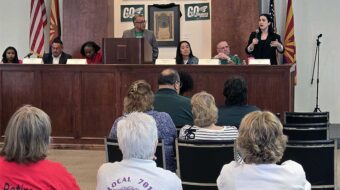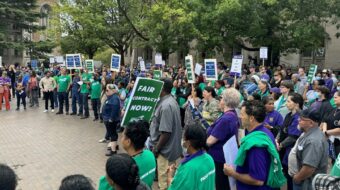
Wow. Last week there was yet another out-of-state special interest group trying to tell New Hampshire how to run OUR government. “State’s ‘stunning pensions’ called lavish by taxpayer group.”
There are so many things wrong with this that it’s hard to know where to start.
First, consider the source of the story. “Taxpayers United” is actually a tiny organization based in Chicago. It has only one full-time employee: its president, James Tobin, a former Elmhurst College economics professor who reportedly founded the organization back in 1976.
Since that time, the organization’s focus has wandered from issue to issue. According to the marketing pitch for anyone who wants to purchase their mailing list, Taxpayers United is now focused on “the repeal of the 16th Amendment and doing away with the income tax in favor of a consumption or flat tax.” But it must be easier to generate headlines by attacking public employees than by proposing to amend the US Constitution. Last month, Taxpayers United was making headlines attacking public employee pensions in North Carolina. Before that, it was attacking pensions in Minnesota, Kansas, and Indiana.
Odd, how this tiny organization keeps making headlines about something that is so far removed from its goal of changing the Constitution. Is it because headlines are a good way for the organization to attract the donations necessary to keep it in business? Free publicity is sure a good way to find those donors who are described in the mailing list pitch as “highly responsive and are vigorous financial backers of any effort to reduce the size of government and cut taxes.”
Now, the actual facts.
In New Hampshire, public employee pensions aren’t exactly “paid by taxpayers.” Step away from the right-wing rhetoric and think about this for a minute. City of Manchester retirees don’t get their retirement checks from the City of Manchester. Retired Concord teachers don’t get a monthly direct deposit from the City of Concord.
In actual fact, these pensions come from a retirement system that is primarily funded by long-term investment returns. In fact, about 75 cents of every dollar paid in pension benefits comes from investment returns. Most of the rest is attributable to workers’ contributions to the system. The employer’s contribution – the taxpayers’ portion – represents only a few pennies of each pension dollar – and even that amount was contributed by the employer many years (or even decades) ago.
One very important part of the New Hampshire Retirement System is that public employees are not eligible for social security. This means that their pension is the only income they will get in their retirement.
Public employers used the New Hampshire Retirement System to push wage costs off into the future, because the lower pay offered by government agencies was balanced by promises of retirement security. It only took a few percentage points of payroll – contributed to the New Hampshire Retirement System – to make up for large disparities between government wages and pay levels offered by the private sector.
In some ways, it was like bonding a school construction project – where a municipality gets the benefits immediately, but pays for it in the future. As Mitt Romney might say, it’s “kicking the can down the road.”
But then Wall Street led the economy astray.
As recently at 1999, the New Hampshire Retirement System was more than 100% funded. But then the Trust Fund lost 10% of its value in the recession of 2001. It lost another 25% of its value in the 2008 recession.
It happened all around the country. At the same time that public pension funds were losing value due to Wall Street greed, new accounting standards were focusing public attention on the systems’ unfunded liabilities. Anti-government pundits used the situation to attack public sector pensions and call for pension “reform”.
Lost in all their rhetoric was one basic fact: the trillion dollars in unfunded public pension obligations were the same trillion dollars of public pension funds lost to Wall Street.
In June 2007, before the Wall Street meltdown, the NH Retirement System had $5.9 billion in investments, including
- $29.7 million of stock in Citigroup, Inc.
- $23.5 million of stock in American International Group, Inc. (AIG)
- $14.0 million of bonds issued by Federal Home Loan Mortgage Corp. (Freddie Mac)
- $13 million of bonds issued by Federal National Mortgage Association (Fannie Mae)
Two years later, when the recession was in full force,
- Citigroup stock had plunged to only about 6% of its former value
- AIG stock was worth only about a penny on the dollar
- Freddie Mac and Fannie Mae had both been placed into federal conservatorship
and the anti-government pundits were getting lots of headlines attacking public employees’ pensions.
Since then, employers’ contributions have increased significantly, to make up some of the money that was lost to Wall Street. And the NHRS Trust Fund has in fact recovered a lot of ground -it is now almost back to where it was in June 2007. Give it another decade of steady investment returns, and the System might be back to 100% funded.
But the Republicans are trying to repeal the Dodd-Frank Act, which was passed to prevent the worst of the Wall Street abuses from happening again. In the meantime, the financial industry is spending $100 million a year on lobbyists trying to create loopholes in the regulations.
And anti-government pundits are still making headlines attacking public employees’ pensions.
What’s that old saying about “those who don’t remember history”…?
Together We Can Fight Back Against The Attacks On Labor, Share This Message…
Reposted with permission from The New Hampshire Labor News. Check their site for other columns of interest.










